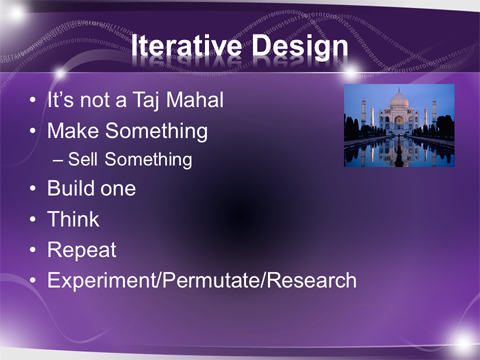
 This is a very fun word. Everyone wants their prototype. How much for a prototype? A prototype in the world of product development can mean just about everything from the Popsicle stick project you made in your living room to the first product that comes off a pilot production line. If it’s not your final production run, it’s a prototype.
This is a very fun word. Everyone wants their prototype. How much for a prototype? A prototype in the world of product development can mean just about everything from the Popsicle stick project you made in your living room to the first product that comes off a pilot production line. If it’s not your final production run, it’s a prototype.
Consider the origin of the word “prototype”:
c.1600, from French prototype (16c.) and directly from Medieval Latin prototypus “original, primitive,” from Greek prototypon “a first or primitive form,” noun use of neuter singular of prototypos “original, primitive,” from protos “first” (see proto- ) + typos “impression, mold, pattern” (see type (n.)). In English from 1590s as prototypon.
So think ‘first impression’.
I try to use a few more specific phrases to help articulate what the various forms of a prototype.
- Proof of concept – This would be an early level prototype that includes many of the final features, but usually has a low level of customization. Typically we can take a few off the shelf devices, modify them, program them, etc., and prove the concept the inventor has in mind is practical. They can then be used for raising early stage funds and validating your idea to focus groups. They are generally not the prettiest things in the world, but they are a good start.
- Functional Prototype – This is a mid-stage prototype which usually has a high level of customization. Most components are custom or designed for volume purchasing at this point. Most of the features are in place. There may be some compromises on functionality due to cost or time constraints.
- Pilot Run – This is a late stage prototype which you have before you start production without the engineers. At this stage the device should represent what you intend to sell. If you find issues here, you iterate, make minor changes and try again.
It’s important to state that there is a large continuum of what your prototype will be. You can start out with very low tech methods, as I call ‘Garage and a glue gun’, and work your way up to a professionally made, ready to show the market device.
You must start though. Don’t be afraid of making something ugly or that it won’t come out right. It won’t. You will get better. Failure is OK. Start somewhere and keep on working on it.
Iterative Design
 Design and engineering don’t happen all at once. Most famous painters don’t paint the perfect picture first time out. With oil paints, you can just keep painting on top of what you have until it looks the way you want. Your product will not be perfect the first time. Keep making prototypes until it’s the way you want it. Of course this needs to be tempered with budget constraints and your time. Experiment, permutate (make different variations), research, test, and do it all over again. Dyson famously made 5,127 of his vacuum. Edison had over 10,000 attempts at his light bulb.
Design and engineering don’t happen all at once. Most famous painters don’t paint the perfect picture first time out. With oil paints, you can just keep painting on top of what you have until it looks the way you want. Your product will not be perfect the first time. Keep making prototypes until it’s the way you want it. Of course this needs to be tempered with budget constraints and your time. Experiment, permutate (make different variations), research, test, and do it all over again. Dyson famously made 5,127 of his vacuum. Edison had over 10,000 attempts at his light bulb.
Garage and a Glue Gun
This is where you just have to start somewhere. Everyone can use tools to some degree. The more you use them, the better you’ll be with them. Sketch, illustrate, research, learn, experiment, modify, and create. Repeat. It will not be perfect. The greatest obstacle to finishing a task is starting. Also, this is a good time to take out your camera phone. These early documentation steps will provide great entertainment for later and possibly help you defend your ideas.
Professional Prototype
After you’ve done some of your initial experimentation, and you have a plan, it’s time to consider a professional prototype. You don’t need to be an expert at everything. You should be very familiar with your product and have some very specific ideas about what it should be in the end. When you approach a professional, you should have a written document. It doesn’t need to be a full specification, but it should have the things that you care about along with the known unknowns; the things you know you need their help with.
A professional prototype development company should have a wide range of resources. They will have better tools, machines, toys, skills, and disciplines. Generally, a combination of electrical and mechanical engineering will be required for most projects, however if there are other specialties required, make sure they have access to those other skill sets either through contractors or partner companies.
When working with a professional service, especially product development services, be sure you understand your agreement. Various companies have vastly different business models that may or may not be agreeable to you. Be sure you understand what you are paying, what you are getting, and who owns what. It is possible for you to pay for a design and not own it. Some firms will work for sweat equity in part or in full which is great to save you money, but treat them like you would any other partner, as you will be working with them for a long time.
Conclusion
While I’ve tried to make this exhaustive, it by no means is. Every idea and business plan will have its own nuance and particulars. Product development is a tough road no matter how you slice it. I think the hardest part of it is that the capital required to physically create something just to sell the first one is usually pretty high. On the other hand, there is a lot of activity in software and web products there is more of a gradation in how quickly you can start marketing your product and the intangible aspect of it. There are still many great product ideas out there waiting to be found and executed. I personally love creating tangible products and entrepreneurship, so that’s what I do every day and I feel it’s all worth it.
Resources
- Anidea Engineering Blogs
– http://www.anidea-engineering.com/blog/
- LMP, Inc.
– http://www.lmp-solutions.com/
- Inventing Daily
– http://www.inventingdaily.com/
- Sketch Up
- TinkerCad
Web References
- Documenting Your Idea
– http://www.docie.com/patenting-help/documenting-your-idea/
- Document your Invention or Idea
– http://www.veritek.com/Media/EDocs/documenting_the_idea.pdf
- 3 Things You Need to Know About Launching a Product Business
– http://www.entrepreneur.com/article/230068
- Launching a Product Business
– http://www.entrepreneur.com/article/230068
- How to Build a Billion Dollar Business Plan
Angel Groups
- Angel Forum of Florida
- Gulf Coast Venture Capital Association
- New World Angels
– http://www.newworldangels.com/wp/
- Tamiami Angel Fund
